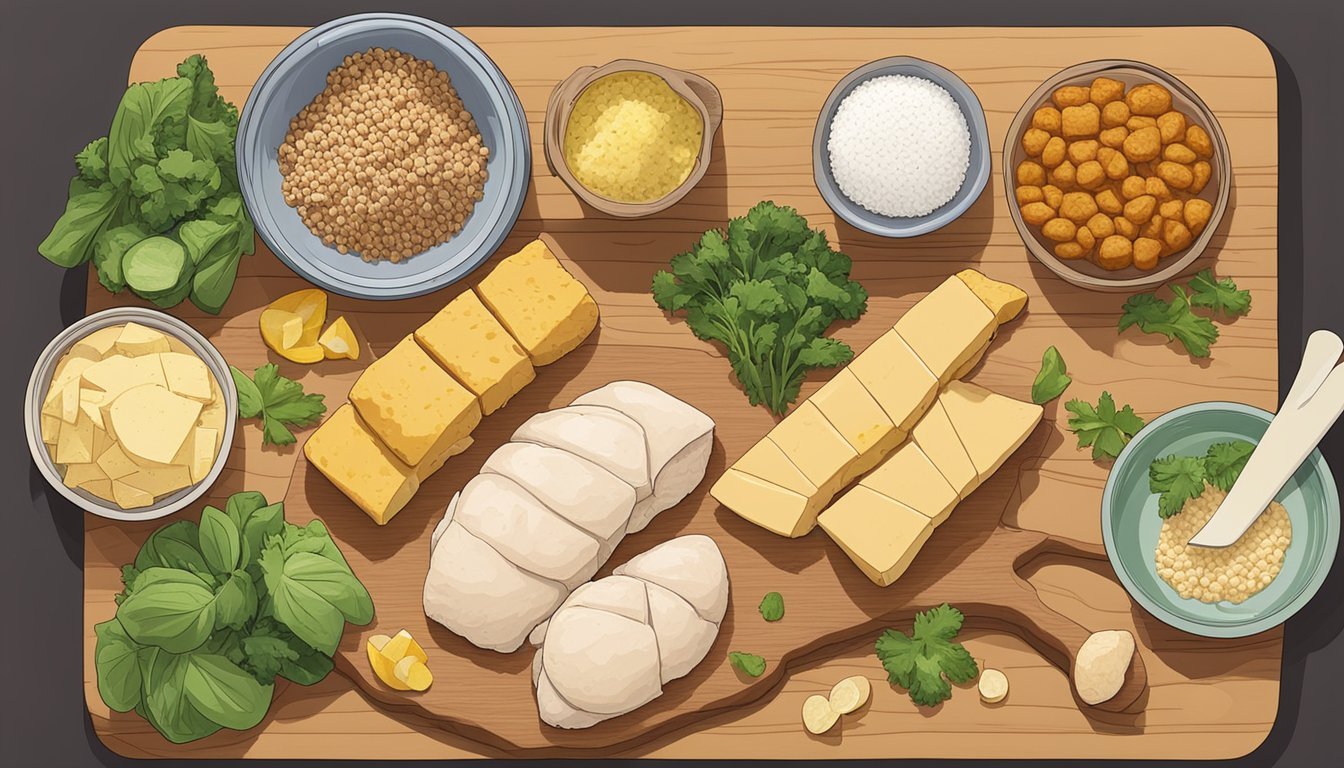Chicken Breast Substitutes
Top Alternatives for Your Recipes
For those seeking to reduce their meat consumption without sacrificing flavor and texture, chicken breast substitutes offer a compelling alternative. Options such as Quorn, seitan, and cauliflower provide both nutritional benefits and culinary versatility in vegan and vegetarian diets.
Quorn is a mycoprotein-based meat substitute with a similar texture and flavor to chicken breast. It can be used in a 1:1 ratio in recipes, making it an easy switch for those new to plant-based eating. Seitan, made from wheat gluten, closely mimics the chewiness of meat, absorbing flavors well in dishes like stir-fries and stews.
Cauliflower presents a whole food option that can take on various seasonings and dishes. Its ability to absorb flavors makes it suitable for numerous recipes, offering a healthy, nutritious alternative. These substitutes not only align with vegan and vegetarian diets but also contribute to a more sustainable and diverse culinary experience.
Overview of Chicken Breast Substitutes
Chicken breast substitutes provide a variety of nutritious and flavorful options suitable for different dietary restrictions. These alternatives often match the meaty texture and protein content of chicken breast, making them excellent choices for various dishes.
Health and Dietary Considerations
Chicken breast substitutes can cater to various dietary needs including vegan and gluten-free diets. Tofu and tempeh, both soy-based, offer high levels of protein, iron, and are versatile in absorbing flavors. Seitan, made from wheat gluten, presents a chewy texture similar to meat but is not suitable for those with gluten intolerance.
Other alternatives like Quorn, made from mycoprotein, and jackfruit, known for its fiber content and mild flavor, provide low-fat, high-protein options. These substitutes often contain fewer calories and fat than traditional chicken breast, contributing to a healthy diet without compromising on nutrients.
Balancing Taste and Texture
When replacing chicken breast, it is crucial to consider both taste and texture. Seitan and Quorn are popular for their meaty texture, making them ideal for recipes requiring a similar chewy consistency. Tofu and tempeh, while different in texture, excel in absorbing various flavor profiles through marinades and seasonings, offering a customizable taste.
Jackfruit stands out for dishes needing a shredded texture, often used in tacos or salads. These substitutes can be seasoned and cooked to mimic the mild flavor of chicken breast, ensuring the final dish maintains its intended taste and consistency.
Plant-Based Protein Alternatives
To meet nutritional needs and enjoy varied flavors, individuals can choose from several plant-based protein alternatives. These options provide substantial protein content and can be creatively incorporated into meals.
Tofu: A Versatile Staple
Tofu, made from soybeans, is a versatile protein source that can suit many dishes. It offers high protein content and is available in various textures such as silken, soft, firm, and extra-firm. Notably, extra-firm tofu holds up well during cooking and absorbs flavors effectively.
To enhance its flavor, tofu can be marinated, baked, stir-fried, or even grilled. Freezing tofu before cooking it can improve its texture, making it more meat-like. Whether used in soups, salads, or main courses, tofu retains a prominent place in plant-based cuisine.
Tempeh: The Fermented Option
Tempeh, made from fermented soybeans, is another nutritious and protein-rich alternative. Its firm texture and nutty, earthy flavor make it unique compared to other substitutes. High in both protein and fiber, tempeh also provides essential vitamins and minerals like iron.
Since it is fermented, tempeh has probiotic benefits which aid digestion and improve gut health. It can be sliced, cubed, or crumbled, making it suitable for various recipes such as stir-fries, sandwiches, and salads. Cooking tempeh with sauces allows it to absorb flavors well.
Seitan: The Wheat Meat
Seitan, or "wheat meat," is made from vital wheat gluten and is renowned for its high protein content. It closely mimics the texture of meat, making it a popular choice for those transitioning to a plant-based diet.
Seitan has a chewy texture and a neutral flavor that adapts well to seasonings and marinades. It can be used in a range of dishes, from skewers and stir-fries to sandwiches. It’s important to note that, unlike tofu and tempeh, seitan is not soy-free, which may be a consideration for those with allergies.
Legumes and Beans
Legumes and beans, such as chickpeas, lentils, and garbanzo beans, provide rich sources of protein, fiber, and iron. They are affordable, widely available, and can be incorporated into a variety of meals.
Chickpeas, for instance, have a hearty texture and mildly nutty flavor. They can be used in salads, roasted for snacks, or blended into hummus. Lentils, which come in different varieties like green, brown, and red, are excellent for soups, stews, and curries.
Beans offer versatility and nutrition, making them a cornerstone of plant-based diets. They can complement other protein sources or stand alone in many recipes.
Other Meat Substitutes
When looking for alternatives to chicken breast, there are numerous options that cater to different dietary preferences and needs. These substitutes range from tropical fruits like jackfruit to mycoprotein products such as Quorn, as well as processed vegan chicken substitutes and whole food replacements.
Jackfruit: The Tropical Stand-In
Jackfruit is a tropical fruit that has gained popularity as a meat substitute, particularly for dishes like pulled chicken. The fruit has a fibrous texture that mimics the consistency of shredded poultry. Its neutral flavor allows it to absorb sauces and spices easily, making it a versatile addition to various dishes.
When ripe, jackfruit becomes sweet and is often used in desserts. For savory dishes, young, unripe jackfruit is preferred. It provides a satisfying texture without overwhelming the dish's intended flavor profile.
Nutritional Content:
Low in calories
Moderate amounts of fiber
Lacks protein compared to other meat alternatives
Usage: Ideal for vegan tacos, sandwiches, and curries.
Quorn and Other Mycoprotein Products
Quorn is a mycoprotein-based meat alternative derived from fungi. It is known for its meat-like texture and is often used in place of chicken breast in various recipes. Quorn products are usually fortified with vitamins and minerals, enhancing their nutritional profile.
Mycoprotein has a high protein content and low fat, making it a popular choice among those looking for a healthy alternative to meat. Other brands producing mycoprotein products include Fry's Family Foods and Garden Gourmet.
Nutritional Content:
High in protein
Low in saturated fat
Rich in fiber
Usage: Suitable for stir-fries, baking, and grilling.
Processed Vegan Chicken Substitutes
Processed vegan chicken substitutes provide a convenient and ready-to-cook option for those who want to avoid meat. Brands like Gardein, Beyond Meat, Tofurky, Field Roast, Morningstar, Boca, and Sweet Earth offer various chicken-like products such as strips, nuggets, and patties.
These products are often made from soy, pea protein, or wheat gluten, providing a chewy texture that resembles real chicken. They are typically seasoned to replicate the taste of chicken and are easy to incorporate into everyday meals.
Nutritional Content:
Varies by brand
Generally high in protein
May contain significant amounts of sodium
Usage: Perfect for quick meals like salads, wraps, and quick stirs.
Whole Food Replacements
Whole foods such as cauliflower, mushrooms, eggplant, and quinoa serve as excellent plant-based chicken alternatives. These ingredients are not processed and offer a more natural approach to meat substitution.
Cauliflower can be roasted or fried to create a crispy texture. Mushrooms, with their umami flavor, provide a satisfying depth to many dishes. Eggplant is often used in Mediterranean recipes, offering a meaty bite, and quinoa serves as a protein-rich base for various meals.
Nutritional Content:
High in vitamins and minerals
Varying levels of protein and fiber
Low in fat
Usage: Ideal for roasting, stir-fries, and baking.
Incorporating Substitutes into Recipes
Incorporating chicken breast substitutes into recipes can elevate your dishes while providing alternative protein sources. Explore different cooking methods to best utilize these substitutes and achieve delicious results.
Cooking Techniques and Methods
Stir-Fries: Stir-fries are a versatile way to use seitan, tofu, or pea protein instead of chicken breast. These substitutes absorb flavors well. To prepare, cut the alternative into bite-sized pieces and marinate in soy sauce, garlic, and ginger. Quickly cook in a hot pan with vegetables and serve over rice or noodles.
Curries: For curries, try alternatives like paneer or seitan. Paneer maintains its firmness and absorbs curry spices, while seitan can provide a meaty texture. Simmer pieces in your preferred curry sauce until tender.
Baked Dishes: Tofu and tempeh are ideal for baked recipes. Press tofu to remove moisture and marinate in a mixture of olive oil, herbs, and spices. Bake until golden brown. Tempeh can also be marinated and baked to add texture and flavor to casseroles.
Marinated Options: Marinades enhance the substitutes’ flavors. Mix ingredients like lemon juice, olive oil, garlic, and herbs. Soak tofu, seitan, or tempeh for at least an hour before cooking. This method is suitable for grilling or baking, providing a depth of flavor.
Sauces and Seasonings: Adjust seasonings and sauces to complement the substitute used. For instance, cauliflower in stir-fries can benefit from bold spicy sauces, while tofu works well with creamy, tangy dressings. Experiment with different combinations to find what suits your taste best.
Nutritional Profiles and Health Benefits
When considering alternatives to chicken breast, it is important to evaluate the nutritional profiles and health benefits of each option to determine which is the best fit for various dietary needs.
Comparing Protein and Nutrient Density
Chicken breast is well-regarded for its high protein content, providing approximately 31 grams of protein per 100 grams. It is also low in fat and calories, making it an excellent choice for those seeking lean protein sources.
Chickpeas offer a plant-based alternative with significant protein, fiber, iron, and a range of vitamins and minerals. They contain about 19 grams of protein per 100 grams, making them a robust option for those on vegetarian or vegan diets.
Turkey breast is another substitute that closely mirrors the nutritional profile of chicken breast, with similar high protein content and low fat.
Tofu is a versatile meat substitute, providing roughly 8 grams of protein per 100 grams. It is also rich in iron and calcium, beneficial for bone health, and often fortified with additional vitamins like Vitamin B12.
Advantages for Specific Diets
A chicken breast is naturally gluten-free and soy-free, fitting well into a variety of dietary restrictions. It is also compatible with low-carb diets due to its negligible carbohydrate content.
Chickpeas add valuable fiber, which is essential for digestive health, and are suitable for gluten-free and vegan diets while being soy-free.
Tofu suits vegan and vegetarian diets, offering a plant-based protein source that is low in calories and can be adapted across numerous recipes. It is important to check for any allergens like soy when considering tofu.
Turkey breast behaves similarly to chicken breast in nutritional content and can be a suitable replacement for those needing a mild, high-protein option that is also gluten-free and low in fat.
Each alternative offers unique nutritional benefits that can cater to specific dietary needs, ensuring a varied and balanced diet.




